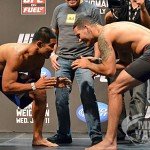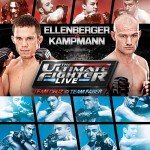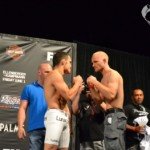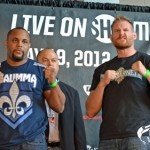The Fountain of Youth: TRT in MMA
 Talk of TRT has been rampant in the MMA world following Vitor Belfort’s fight against Michael Bisping, and with good reason. Coming into the cage is the best shape of his life; Belfort easily dismantled the top-flight Middleweight, severing his ties to consciousness with a head kick in the second round. Many marveled at Belfort’s physique yet everyone knew this wasn’t any incredible work-out routine that gave him the body of a twenty-five year old well into his thirties. This was aid of a chemical kind, and it’s all perfectly legal within the sport.
Talk of TRT has been rampant in the MMA world following Vitor Belfort’s fight against Michael Bisping, and with good reason. Coming into the cage is the best shape of his life; Belfort easily dismantled the top-flight Middleweight, severing his ties to consciousness with a head kick in the second round. Many marveled at Belfort’s physique yet everyone knew this wasn’t any incredible work-out routine that gave him the body of a twenty-five year old well into his thirties. This was aid of a chemical kind, and it’s all perfectly legal within the sport.
A disclaimer: I’m not a doctor of any sort. I hold no degrees and have done exactly zero research. Yet, this doesn’t disqualify me from an opinion, provided that opinion exists outside of those fields of science and sports medicine. My opinion is that of a martial artist, a sports fan, and a rabid traditionalist.
What I know about TRT is this: It was invented to help men who’d suffered injury to their genitals, whether through accident or cancer, to remain men. When the testicles are removed or prostate damaged, the male body begins to wilt from the imbalance of chemicals in the body. Bones become brittle, sex drive disappears and muscles, including the heart, suffer greatly. This therapy was used, at some risk of future problems, to regulate men so they could remain physically and mental sound.
Of course, from noble roots grow bitter fruit. Over time, people realized that every man suffers from a loss of hormones, albeit gradually with age, and this fact was thrown into everyone’s face as the age of the internet came. Men were suddenly aware that they were aging and were also aware they could buy legal supplements (which worked remarkably like steroids) to regain their old vigor.
In the ultra-competitive world of professional sports, steroids were nothing new. Folks have been finding ways to dope their body since the bare-knuckle boxing and carnival wrestling days. Yet the legality of these things within sports has shifted time and again. Chemical engineers have always been a step or two ahead of the athletic commission’s contracted laboratories, and often these chemists actually worth both sides of this equation. As one substance becomes a no-no, there’s always something to replace it that folks don’t know to look for yet. Chemists make something new and the game goes on and on.
TRT broke this cycle however in its utter simplicity. Why not just have ways to allow an exemption for using previously banned chemical enhancement? Suddenly, the rush isn’t to find out what the new undetectable super-supplement is, but rather to find a doctor that will give you the TRT exemption. The argument as to if it’s medically needed or not will be lost in the shuffle, and really isn’t the focus here. The focus is on TRT, because it didn’t just break the cycle of the measure/counter-measure of doping, but it broke the cycle of combat sports.
The Cycle of the Combat Athlete
In a nut shell, every fighter, outside of combat sports athletes transitioning from other sports will follow the same path. Fighters start their actual career as amateurs these days, working almost as an internship; fighting for free for future gains. Many fighters wash out immediately, as the rigors of training, weight cutting and actual full-contact fight are there to send the undedicated packing. Even lackluster amateurs eventually make it into the pros on the bottom floor, generally on the regional level and against many of the same guys they faced as amateurs.
As time goes on, you either pick up wins or you don’t. While MMA isn’t half as unforgiving as boxing in terms of records, losses early in a career can create a ceiling for a fighter that’s not breakable without spilling an awful lot of blood. Guys who lose stay at the bottom of a division in the region and guys who win move up the ladder and find other opportunities. Minor show titles are always popular for upcoming fighters, and soon the region is too small for a solid prospect. He moves to a bigger stage and bigger challenges.
Eventually, a man hits his peak. Physically, this is around 27-31 years old, and if you’re not at the top-tier of the fight game by then, you’re not likely to go higher. In this time they’ve battled past fellow regional opponents, as well as the myriad of big show castoffs that can’t hack it at those levels of competition anymore. Once they’re into their mid to late 30′s, it’s treading water if they’re lucky or suffering a backslide as the younger, stronger guys take their place on the marquee.
At some point, you fade out. It’s a natural process of life, as the body picks up injuries, reflexes slow, and endurance seems to disappear faster than ever. The power never leaves a fighter and skills and experience picked up on the way make these hardened veterans dangerous. You wish for good things for these guys as they move onto coaching gigs, go back to old jobs or settle in for a retirement if they’re lucky. They train the next wave of fighters, and the cycle continues.
The Fountain of Youth
While we all enjoy seeing fighters we grew up watching doing well, it’s an unnatural progression that will keep others from taking their place. Rather than have the peak and decline, TRT uses can stall nature and remain on an even playing field with young talent far beyond a normal time frame.
Now we see fighters like Vitor Belfort and Dan Henderson having an unnatural resurgence. Years ago, Belfort was on his way out of the sport, surviving on name recognition alone, but is now physically larger than ever and knocking on the door of his third title shot in a handful of years. Dan Henderson was beginning to struggle in fights against the middle of the Pride pack in 2007, yet after being approved for TRT, has maintained his status at a main event fighter into his early 40′s.
At this point, you’re probably wondering what all that had to do with TRT. Here it is:
That downslide older fighters suffer is important for the sport.
Grab any fight record of any fighter on the last big PPV and you’ll see familiar names of fighters a generation ago. The stars of today had to face the stars of yesterday on their way up the ranks, and those are the pivotal bouts of their careers. This is important not only as personal growth for that young fighter, but to allow their name to reach ears of fight promoters that can take them to the next level, draw fans and sponsors, and get them into higher profile fights.
Jose Aldo launched his WEC career off the back of Brazilian MMA legend Alexandre Nogueira. GSP’s major turning point in his career was rematching Matt Hughes, having lost to him two years earlier. Cain Velasquez put himself on the radar by knocking out the formerly invincible Big Nog. In a time before TRT, these fighters were on their way back down the rankings, there to test the youth of the sport and enjoy a few more competitive years as best they could.
The exclusion of these older fighters in this natural progression of sports isn’t only a blow to fighters, but to promoters as well who fill seats at the smaller shows with the inclusion of older elite fighters. There isn’t a weekend that goes by that doesn’t have an event headlined by a fighter in their forties at this point, with a wealth of young talent filling out that roster.
The oldest sports analogy comes from nature: The old lion and the young lion. The old lion matches his cunning and experience against the young lion’s energy and hunger, and when it’s time for him to take over the pride, the young lion defeats the old. If the old lion never truly ages, the story isn’t the same, and neither is the world of combat sports.












